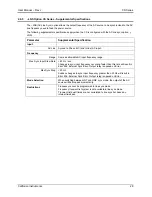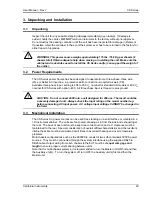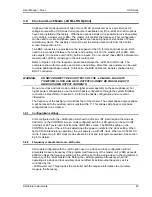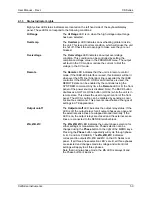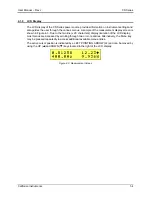
User Manual – Rev J
CS Series
California Instruments
42
3.7
Basic Initial Functional Test
CAUTION:
Work carefully when performing these tests; hazardous voltages
are present on the input and output during this test.
Note: Never program a current source with the output terminals open-circuit. A
no load is a short circuit.
Refer to Figure 3-7 for the required functional test set up. Proceed as follows to perform a basic
function check of the power system:
1. Verify the correct AC line input rating on the nameplate of the CS unit(s) and make sure the
correct three-phase line voltage is wired to the input of the CS before applying input power.
2. Connect a suitable resistive or other type load to the output of the CS. Suggested load
values for the 135 range rounded up to the nearest 0.1 Ohm are shown in Table 3-10.
Make sure the power resistor has sufficient power dissipation capability for full load test and
that the load used does not exceed the maximum power rating of the AC source. For three
phase configurations, this test can be performed on one phase at a time if needed.
3. Connect an oscilloscope and DMM / voltmeter to the AC source output. Set both for AC
mode.
Note:
The voltage across the output will only be representative of the actual output current
if a purely resistive load is used.
4. If the correct AC input voltage is present, turn on the CS unit(s) by closing the On/Off circuit
breaker on the front panel of both chassis.
5. Program the low voltage range, the output current to 0 amps and close the output relay with
the OUTPUT ON/OFF button. There should be little or no output although the DMM may
show a noise level, especially if the DMM is in auto ranging mode.
6. Select
the
Set
screen and use the shuttle to program a small current (0.5 A). Observe the
DMM reading. The reading should track the programmed current.
7. Also monitor the scope. The output should be a sinusoidal voltage waveform.
8. If the output tracks, increase the current until you reach 100 % of the current range. Check
the output voltage reading and waveform.
9. Select the measurement screen by pressing the
Meas
button. The output current, voltage,
and power will be displayed. For three phase configurations, use the PHASE button to
select individual phase data. If all phases are loaded equally, the same current and power
should be visible for all three unless the currents are not programmed to the same level. If
only one phase is loaded, current and power will only be shown for the loaded phase.
In the unlikely event the power source does not pass the functional test, refer to the calibration
procedure in Section 6 or call California Instrument’s customer satisfaction department for
further assistance. The voltage across the load will not represent the actual current unless the
load resistance is better than 0.1% at the programmed current level.
Содержание 13500CS/3
Страница 5: ...User Manual Rev J CS Series California Instruments 5 SAFETY SYMBOLS ...
Страница 34: ...User Manual Rev J CS Series California Instruments 34 Figure 3 3 9000CS 2 Wiring diagram 3 Phase mode ...
Страница 35: ...User Manual Rev J CS Series California Instruments 35 Figure 3 4 13500CS 3 Wiring diagram 3 Phase mode ...
Страница 36: ...User Manual Rev J CS Series California Instruments 36 Figure 3 5 18000CS 4 Wiring diagram 3 Phase mode ...
Страница 56: ...User Manual Rev J CS Series California Instruments 56 The power source is now ready to be used ...
Страница 73: ...User Manual Rev J CS Series California Instruments 73 ...
Страница 111: ...User Manual Rev J CS Series CS Series 111 voltage rating 28 W Weight 22 Wiring AC input 30 ...

